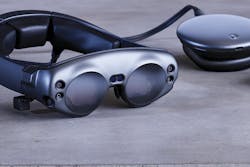Wearables are nothing new, at least not in the consumer world. They are often natural extensions of other smart devices consumers already use daily. However, wearables have yet to make a big (sustainable) splash within manufacturing.
Of course, the possibility of incorporating smart wearables into the manufacturing environment is intriguing. Consider the benefits of being able to provide workers with work instructions that go beyond explaining a new job by visually guiding workers through each step operation. Not only would the ability to overlay data on an active production line dramatically reduce the learning curve, it could prove instrumental in helping workers identify potential problems in the supply chain before they happen.
Or, the possibility of providing maintenance teams a tool capable of visually pinpointing a machine problem and then providing step-by-step repair instructions on a legacy machine. If organizations can embrace this type of offering today, it could play a key role in filling the skills gap. Imagine being able to permanently capture and then convey that valuable knowledge in a dynamically streamable fashion including access to notes, voice recordings, directions and metadata.
Signs of life?
While these examples have been little more than theory, a recent introduction from start-up Magic Leap shows promise. With a focus on changing how users consume digital information by leveraging machine learning, computer vision, sensors and human-centered AI. Unlike augmented (AR) or virtual reality (VR), Magic Leap’s head-mounted digital lightfield display applies advancements in spatial computing that work with the human eye-brain system to integrate digital content in the physical world.
“It combines artificial intelligence and computer vision to seamlessly blend digital content into your reality,” says Magic Leap’s Cathy Hackl. “It’s a lightweight wearable computer that uses eye tracking and head pose to see what the user sees with the power to learn.”
What makes Magic Leap different is that its system “senses your environment by meshing your space. The system also senses you and allows for digital objects to exist realistically in your surroundings,” says Hackl. “Content is spatially aware. If I throw a digital ball and it hits that wall, the ball will bounce back because it understands there’s a wall there. This awareness of the user and the space incorporates sensors, IoT and AI.”
From concept to reality.
Understandably, bringing this product to market required a mix of cutting-edge optics, spatial light modulation, projection systems and precision mechanics—along with sophisticated engineering, manufacturing and supply chain expertise. Magic Leap teamed up with St. Petersburg, FL-based manufacturing giant Jabil to bring its concept to life.
This partnership allowed Magic Leap to tap into Jabil’s extensive manufacturing expertise including injection molding capabilities as well as a vast knowledge base in incorporating optical systems and technologies into end products. Jabil’s optics expertise spans the globe, encompassing an Optics Technology Innovation Center in Israel, optics capabilities in Jena, Germany and advanced active alignment automation in Boston.
Even with expertise and experience, manufacturing new products – especially emerging technology – always encounters challenges. In this instance, the biggest manufacturing challenge dealt with miniaturizing the various technologies involved in a way that still yielded a device was both wearable and effective, explains Jabil’s Green Point CEO and EVP Kenny Wilson. “Creating something that people would use for more than a few minutes at a time meant that we needed to focus eliminating potential problems for users,” he says. The challenge was to get it to a point where the device would not give users headaches or make them nauseous. Weight and comfort were key.”
Creating a test environment for a program like this was also challenging. “We could not use an off the shelf test suite, it had to be tailored to this product,” he says. “We spent untold hours proving it out with practicality and repeatability.”
Functional or flashy trend?
Let’s face it, tech introductions can easily go in either direction. When something cool hits the market, it understandably gets significant attention. And while garnering attention is part of the battle, staying power is the ultimate goal. Enabling manufacturers to improve training, maintenance and productivity environments would go a long way in delivering staying power.
Wilson tells IndustryWeek that the real key to widespread adoption will come down to applications. “There are immense opportunities, and when people get their hands on the device, they will instantly think of creative ways to use it,” says Wilson “But it will take active involvement within the developer community to expand its usability exponentially.”
Naturally, even with a wealth of applications, content creation will be an ongoing issue for manufacturers to truly benefit from the technology. Of course, if the technology truly delivers most manufacturers will dedicate the time to creating content.
Are you intrigued?
About the Author
Peter Fretty
Managing Editor
As a highly experienced journalist, Peter Fretty regularly covers advances in manufacturing, information technology, and software. He has written thousands of feature articles, cover stories, and white papers for an assortment of trade journals, business publications, and consumer magazines.
